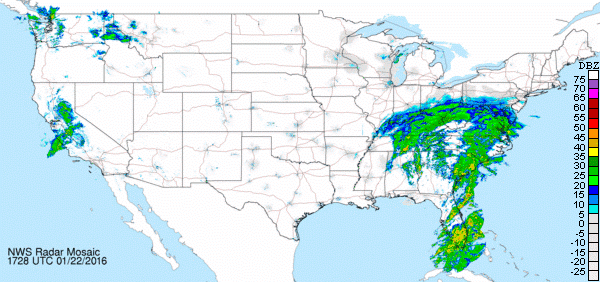NGI Archives | NGI All News Access
CA NatGas Prices Rise on Demand, Aliso Canyon Issues; NE Plummets as “Snowpocalypse” Expected to Cut Power
It’s apparently going to take a lot more than the latest “snowpocalypse” to impress natural gas forwards markets as February fixed prices gained only a few pennies at most market hubs, while Northeast points continued to decline by the double digits, NGI’s Forward Look data shows.

The Nymex February contract rose 4 cents between Jan. 15 and 21 amid some volatility surrounding the week’s storage report.
The U.S. Energy Information Administration reported a 178 Bcf withdrawal from storage inventories for the week ending Jan. 15, which was below estimates ranging from 184 to 189 Bcf, but the largest pull of the winter season so far.
While most other gas markets followed suit, California prices posted more substantial gains for February amid ongoing restrictions on the SoCal system following the leak at the Aliso Canyon storage facility and ongoing strong demand in the region.
At Southern California Border, February climbed 6.8 cents between Jan. 15 and 21 to reach $2.26, according to Forward Look.
Natural Gas markets were closed Jan. 18 in observance of the Martin Luther King, Jr. holiday.
Further out the curve, SoCal Border March was up 5.5 cents to $2.10, but the winter 2016-2017 package fell 6 cents to $3.03, whereas most other markets rose a few cents.
The weakness in the winter strip is likely some correction after a sharp run-up in prices earlier in the month due to ongoing concerns the Aliso Canyon facility could be shut permanently.
Meanwhile, Pacific Gas & Electric citygates February was up 9.6 cents between Jan. 15 and 21 to reach $2.50, while March was up 8.7 cents to $2.48 and the winter 2016-2017 was flat at $3.16, Forward Look data shows.
The strength in California comes as demand in the region has remained strong this month.
Demand has averaged 7.24 Bcf/d during the past seven days, an increase of 1.18 Bcf/d over the previous week, according to Genscape. For the last 30 days, demand has averaged 0.73 Bcf/d higher than year-ago levels.
Genscape, based in Louisville, KY, is a real-time data and intelligence provider for energy and commodity markets.
Meanwhile, work is progressing faster than expected on the relief well being drilled at Aliso Canyon, and SoCal recently issued revised capacity restrictions into its northern and southern Zones to accommodate mitigation of the Aliso Canyon leak.
Northern Zone capacity was revised up to 1,050 MMcf/d from the previous 900 MMcf/d, while Southern Zone capacity was increased to 535 MMcf/d from 460 MMcf/d.
SoCal, however, also announced a capacity reduction of 200 MMcf/d on flows through its Wheeler Ridge Zone (where SoCal receives gas from Kern/Mojave, PG&E and Occidental) that began Jan. 22.
This is the first time that zone has been restricted since the Aliso Canyon leak began, according to Genscape.
Total scheduled receipts for this zone for gas day Jan. 20 were 828 MMcf/d, with 1,290 MMcf/d remaining available, the company said.
Previous zonal capacity restrictions during the Aliso Canyon leak have cut imports and weighed on basis prices, Genscape added. The restrictions, which are being put in place to enable the SoCal system to receive more gas from storage withdrawals, have been intensified in order to reduce Aliso Canyon field pressure.
Across the country in the Northeast, the blizzard conditions forecast for the region over the weekend had a negative impact on prices.
In New England, Algonquin Gas Transmission citygates saw February fixed prices plunge 41.1 cents between Jan. 15 and 21 to reach $2.60, according to Forward Look. March dropped 22.8 cents to $3.92.
Transco Zone 6-New York February was down 19.3 cents to $4.42, while March was down just 2.7 cents to $2.62.
The steep losses in the Northeast come as a major winter storm was expected to arrive in the region over the weekend, dumping more than a foot of snow in some areas and likely causing widespread power outages.
Indeed, Genscape shows demand in New England hitting 3.40 Bcf/d on Saturday but then falling to 3.05 Bcf/d by Tuesday.
Adding to the downward price pressure in New England is the arrival this week of a couple of LNG cargoes in the region that will likely be used to serve the strong demand.
Meanwhile, Appalachian demand is expected to hit 18.94 Bcf/d on Saturday before sliding to 15.90 Bcf/d by Tuesday.
But the break in strong demand is likely to be short-lived as another weather system is expected to follow next week, bringing another round of subfreezing temperatures and areas of rain and snow and resulting in near or higher than normal demand through the week.
Forecasters with NatGasWeather warned, however, the amount of cold expected to be tapped during the week needs refining, and has trended slightly less cold in the latest weather models.
Meanwhile, they are keeping a watchful eye on what happens after Jan. 30-31, when weather data shows milder temperatures arriving.
“It’s quite possible this milder break only lasts for a several day period into the first few days of February before colder temperatures again find ways to spill into the northern and eastern U.S. as the cool bias we’ve been seeing continues,” NatGasWeather said.
Genscape projections currently show New England demand reaching 3.30 Bcf/d on Feb. 1 and climbing to 3.45 Bcf/d by Feb. 5.
Appalachian demand is expected to hit 16.23 Bcf/d Feb. 1 and rise to 17.45 Bcf/d by Feb. 5.
© 2024 Natural Gas Intelligence. All rights reserved.
ISSN © 2577-9915 | ISSN © 2577-9877 |
